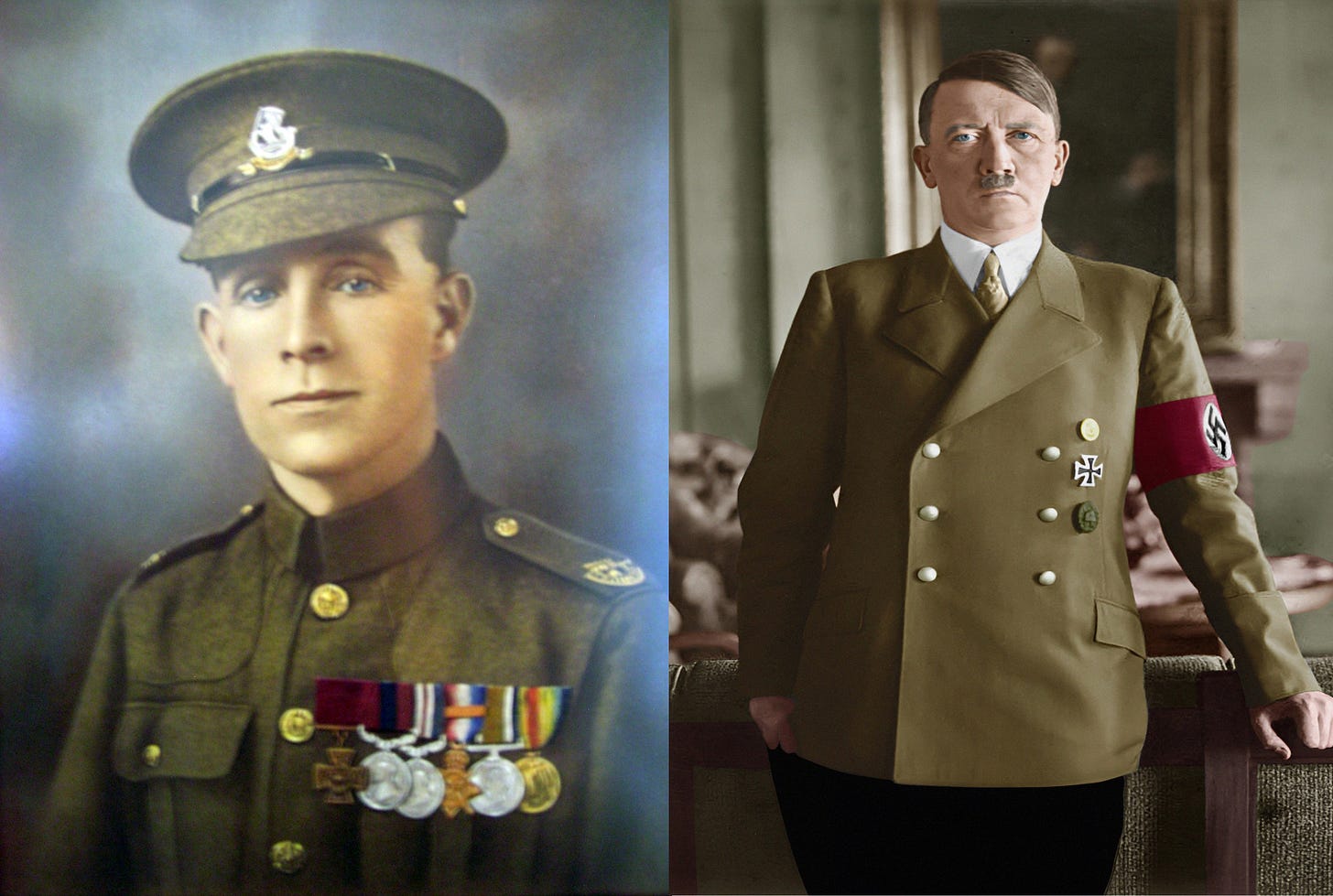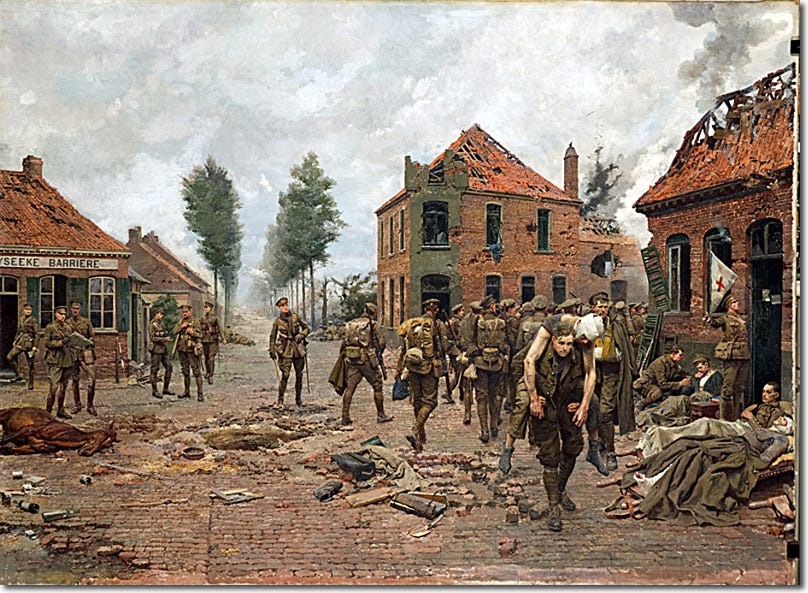Free Article: The Man Who Spared Hitler (Supposedly)
The story of apparently how, for a moment, Hitler nearly never got the chance to become ogre of Europe
Private Henry Tandey had a clear shot at the German soldier. He was so close that he could look his enemy in the eyes. Tandey could not have missed. But the man was wounded; one account of that far away day in 1918 says that the German was lying bleeding on the ground. In any case, the German soldier made no move to resist; he simply stared at the Englishman. Tandey eased off the trigger of his Lee Enfield rifle and did not fire. ‘I took aim,’ said Tandey later, ‘but couldn’t shoot a wounded man. So I let him go’.
The date was 28 September 1918. Tandey was serving with the 5th Duke of Wellington’s Regiment embroiled in fighting for the French village of Marcoing.
The story goes that the German soldier went on his way, and Tandey went his. No doubt the Englishman forgot all about the man he had spared, because Tandey still had a war to fight. Not long afterward Tandey received the news that he had been awarded Britain’s highest award for gallantry, the Victoria Cross (VC). He would receive the VC at in December 1919 from King George V during an investure at Buckingham Palace.
Tandey’s VC was gazetted on 18 December 1918, the citation reading:
For most conspicuous bravery and initiative during the capture of the village and the crossings at Marcoing, and the subsequent counter-attack on 28 September, 1918. When, during the advance on Marcoing, his platoon was held up by machine-gun fire, he at once crawled forward, located the machine gun, and, with a Lewis gun team, knocked it out. On arrival at the crossings he restored the plank bridge under a hail of bullets, thus enabling the first crossing to be made at this vital spot.
Later in the evening, during an attack, he, with eight comrades, was surrounded by an overwhelming number of Germans, and though the position was apparently hopeless, he led a bayonet charge through them, fighting so fiercely that 37 of the enemy were driven into the hands of the remainder of his company.
Although twice wounded, he refused to leave till the fight was won.
Owing to the wounds he received, Tandey was evacuated from the frontlines to a hospital in England.
Tandey was born in 1891, in Leamington, Warwickshire. The son of a stonemason who had also soldiered for Britain, he became a professional soldier, a tough, long-service infantryman who survived four years of bitter war in Belgium and France. Nicknamed ‘Napper’, Tandey was not a large man, standing less than five feet, six inches, and weighing just under 120 pounds. But what he lacked in stature, Napper Tandey made up in grit and high courage.
In August 1907, he had enlisted in the Alexandra, Princess of Wale’s Own Yorkshire Regiment, commonly known until the 1920s as the Yorkshire Regiment. Today the regiment is more commonly known by another name, the Green Howards.
Following basic training, Tandey had served with the 2nd Battalion, Yorkshire Regiment in Guernsey and South Africa before the war. He was a tough, able soldier, and by the time of his exploit at Marcoing he had already been five times Mentioned in Despatches.
Tandey participated in the Battle of Ypres in October 1914 and was wounded on 24 October 1916 during the Battle of the Somme. Upon being discharged from hospital care, Tandry returned to the frontline, being posted to the 3rd Battalion on 5 May 1917 before being posted to the 9th Battalion on 11 June 1917. It was whilst serving with the 9th Battalion that he partook in the Battle of Passchendaele where he was wounded for a second time on 27 November 1917. Recovering from this wound, he returned to the 3rd Battalion on 23 January 1918 before being posted to the 12th Battalion in March 1918. In July 1918 he was transferred from the Yorkshire Regiment to the 5th Battalion, The Duke of Wellington’s (West Riding) Regiment.
On 28 August, during the Second Battle of Cambrai, the 5th Battalion was embroiled in fighting to the west of the Canal du Nord. During the fighting Tandry was in charge of one of several bombing parties on the German trenches. As the forward parties were pinned down, Tandey took two men and dashed across no man’s land under a hail of fire and bombed a German trench before returning to British lines with twenty prisoners. His actions led to the capture of the German positions and led Tandey to be awarded the Distinguished Conduct Medal (DCM).
Following the war, Tandey continued to serve in the British army, serving with the 2nd Battalion, The Duke of Wellington’s Regiment where he saw service in Gibraltar, Turkey and Egypt. In 1920 he was one of fifty recipients of the Victoria Cross who provided a guard of honour inside Westminster Abbey during the ceremonial burial of the Unknown Warrior.
On 5 January 1926, holding the rank of sergeant, Tandey was discharged from the army. Tandey became a commissionaire at the Standard Triumph Works, Fletchamstead, a position he held for 38 years. A modest and quiet man, he talk little about his experiences during the First World War.
With his fighting days well behind him, Tandey’s war should have been over. But it was not. In 1923, the Green Howards Regiment commissioned a painting by Italian artist Fortunio Matani. The painting showed a soldier purported to be Tandey carrying a wounded man at the Kruiseke Crossroads, northwest of Menin, in 1914. The painting was made from a sketch, provided to Matania by the regiment, based on an event at that crossroads. A building shown behind Tandey in the painting belonged to the Van Den Broucke family, to whom the regiment presented a copy of the painting.
Matania’s vivid painting became something far more than a picture, all because of the man who acquired a copy of it.
In 1937, Hitler became aware of the Matania painting, with a copy of it being owned by Dr. Otto Schwend who served as a member of Hitler's staff. Schwend had been a medical officer during the 1914 Battle of Ypres and in 1936 had been sent a copy of the painting by a Lieutenant Colonel Henry Earle, whom Schwend had treated in a medical post at the Menin Crossroads Following the war Schwend and Earle had remained in contact. Schwend gave a large photograph of the painting to Hitler, who purportedly identified the soldier carrying the wounded man as Tandey from the photo of him in the 1918 newspaper. Hitler's adjutant, Fritz Wiedemann, subsequently wrote to Schwend:
I beg to acknowledge your friendly gift which has been sent to Berlin through the good offices of Dr. Schwend. The Führer is naturally very interested in things connected with his own war experiences, and he was obviously moved when I showed him the photograph and explained the thought which you had in causing it to be sent to him. He was obviously moved when I showed him the picture. He has directed me to send you his best thanks for your friendly gift which is so rich in memories.
In 1938 when British prime minister Neville Chamberlain flew to the Berghof to meet Hitler for discussions which would lead to the Munich Agreement and Chamberlain to declare ‘Peace for our Time’, he saw a copy of Matania’s painting. Intrigued by the painting and believing it to be a strange choice for Hitler as it was a work of art which showed only British troops, Hitler pointed to Tandey and commented, ‘That man came so near to killing me that I thought I should never see Germany again, providence saved me from such devilishly accurate fire as those English boys were aiming at us’.
Then Hitler went a step further. ‘I want you to pass on my best wishes and thanks to the soldier in that painting’, he said, whereupon Chamberlain replied that he would contact the man when he returned to England. The prime minster was as good as his word and placed a telephone call which was supposedly answered by nine year old William Whateley, a relative of Tandey’s wife Edith. The story is based on supposition, however, as at the time Tandey lived at 22 Cope Street in Coventry and worked for the Triumph Motor Company. Neither Triumph nor British Telecommunications hold records of a telephone being registered at Tandey’s address in 1938.
It is reported that it was only in 1939 that Tandey found out that the pitiful wounded man he had spared, the bedraggled German corporal in the Bavarian 16th Reserve Infantry Regiment, was now the chancellor of Germany, on his way to becoming the ogre of Europe.
In November 1940, during the German blitz on Coventry, Tandey’s home was bombed by the Luftwaffe. Standing outside his bombed home, Tandey was approached by a journalist who asked him about the alleged encounter with Hitler to which he said,
If only I had known what he would turn out to be [...] When I saw all the people and women and children he had killed and wounded I was sorry to God I let him go.
Tandey died on 20 December 1977 at the age of 86. At his request, he was cremated and his ashes buried in the Masnieres British Cemetery at Marcoing, France on 23 May 1978. Due to French laws it was not permissible for his ashes to be scattered, or any form of ceremony or commemoration made to him.
If a true story, it is interesting to think how history could have been different.





